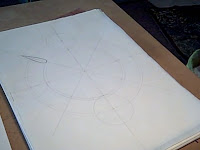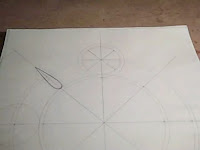Life, being what it is, kind of got in the way of my beginning the rendering of this idea right away. By virtue of the demand of higher priorities, some days passed without opportunity to begin this drawing. As the days passed, I thought that the details would fade. That often happens with other ideas if too much time passes between the time I get the idea and the opportunity to begin working on it. But not so with this one. The details remained just as vivid days later as when the idea first popped into my head. The fact that the details lasted as long as they did served as motivation for me to get to work on this drawing as soon as I could.
This idea, for all intents and practical purposes, was actually quite basic. But it wasn't something that I could just sit down with a pencil and paper and just draw out. And I don't have the equipment or software to let my computer do it. I had to do it directly on paper. I needed to come up with a way to produce this drawing without the markers and guidelines necessary to ensure that it would turn out right. On this line of thinking, the first thing that came to mind was an old, simple trick that I learned in school. All I needed was a compass, some tracing paper, and a soft lead pencil.

 Progress was slow as I had to work out step by step what I needed to do to best achieve the desired results. The image I wanted to produce had a concentric circular frame, so, my first move was to draw out this frame, using the compass, starting on the tracing paper, and then duplicating the drawing on the paper on which I would render the image. After marking out the desired positions of the smaller circular portions of the frame and other elements of the drawing, I duplicated them on the paper used for the actual image (minus the marker/guide lines). I did this by tracing over the elements I wanted to tranfer with a soft lead pencil on the reverse side of the tracing paper. Then, I placed the tracing paper with the original circular frame on top of the duplicate that would become the final drawing, matching up the frame on the tracing paper with the frame on the final drawing paper. Doing this, I made sure that the soft lead (that I used to trace the transfer elements) was between the tracing paper and the final drawing paper. Then, I took something small and rounded (the back end of one of my mechanical pencils) and rubbed over the parts of the image I wanted to transfer. The graphite transferred from the rubbing provided me with the images I wanted added to the circular frame without the unwanted marker and guidelines. With the frame image complete on the what would become the final drawing, all that remained was just to draw out the details of the image.
Progress was slow as I had to work out step by step what I needed to do to best achieve the desired results. The image I wanted to produce had a concentric circular frame, so, my first move was to draw out this frame, using the compass, starting on the tracing paper, and then duplicating the drawing on the paper on which I would render the image. After marking out the desired positions of the smaller circular portions of the frame and other elements of the drawing, I duplicated them on the paper used for the actual image (minus the marker/guide lines). I did this by tracing over the elements I wanted to tranfer with a soft lead pencil on the reverse side of the tracing paper. Then, I placed the tracing paper with the original circular frame on top of the duplicate that would become the final drawing, matching up the frame on the tracing paper with the frame on the final drawing paper. Doing this, I made sure that the soft lead (that I used to trace the transfer elements) was between the tracing paper and the final drawing paper. Then, I took something small and rounded (the back end of one of my mechanical pencils) and rubbed over the parts of the image I wanted to transfer. The graphite transferred from the rubbing provided me with the images I wanted added to the circular frame without the unwanted marker and guidelines. With the frame image complete on the what would become the final drawing, all that remained was just to draw out the details of the image. 
All things considered, the image itself really had no purpose and communicated no message (at least not anything that was in my head). I was just taken by the fact that an image with as much detail would first enter my head, and then, stay there and stay intact for what was something of an unprecedented amount of time. Having that happen, I really just wanted to see what the process from concept to image would yield.








No comments:
Post a Comment